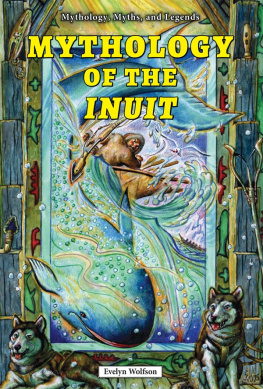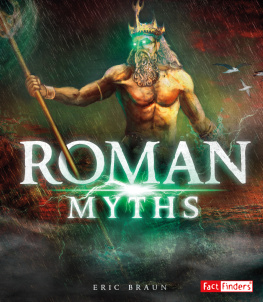Legendary Facts and Fiction
Roman and Greek mythology share many of the same gods and goddesses. However, Roman myths have evolved more from real, historical figures and events than did tales from Greek mythology.
In Mythology of the Romans, Evelyn Wolfson explores the stories of some of the most prominent figures, such as Romulus and Remus, Jupiter, Venus, Mars, and Apollo. Each tale includes a detailed introduction to the complex culture that was ancient Rome, as well as a questionand-answer section and expert commentary written by scholars and specialists on Roman mythology. Find out about the heroes, villains, and epic battles of Roman myths.
... a nice addition to the collection...
ALMA
... good book for students...
Denver Public Schools
About the Author
Evelyn Wolfson has traveled extensively and written articles on the subject of archaeology. Her books have won many literary awards, and are recommended by the Library of Congress.
About the Illustrator
William Sauts Bock has illustrated many books, and his illustrations was honored by the American Institute of Graphic Arts.

My sincere and grateful thanks for expert advice, criticism, and comments to: Dr. Bennett Simon, classicist, psychoanalyst, author, and friend; and to Dacia Wolfson Callen, classicist who took me on an archaeological dig in Carthage and trekked many times over the years through Italy, Greece, and the islands of the Mediterranean and Aegean.
The Roman mythology we know today evolved over hundreds of years. Myths about the earliest Roman deities are different from most traditional myths that explain the actions of gods and goddesses or try to make sense of unexplainable events in nature. Roman myths give reasons for the rituals, ceremonies, and festivals held in honor of specific deities who represented important functions in daily life. The rituals, however, came firstthen myths were created to go with the deities being honored.
Michael Grant, the author of Roman Myths, writes:
In contrast to other peoples (Greeks, Germans, Celts) whose myths were stronger than their rites, the Roman rituals had survived wholly or largely without any mythological accompaniment; and as time went on an assortment of myths was brought in to explain them.
Later, however, Roman myths began to resemble those of the Etruscans and Greeks, and early deities began to take on human form. These gods and goddesses gained personalities and complex genealogies, or family trees.
In addition to myths about deities, the Romans also created two very popular myths about their own origins. One tells the story of the founding of Rome by Aeneas, a young Trojan whose mother was Venus, the goddess of love; and the other tells about the founding of Rome by Romulus, one of the twin sons of Mars, the god of agriculture and war. These myths appeared to read like history. Roman Myths author Michael Grant continues:
Not only did they seek a chronological framework for all the events that had, in the historical sense, happened, but they were just as eager to fit their mythical stories into an equally firm, connected sequence of pseudo-historical, pseudo-chronological narrative...
Myths about the founding of Rome were written by historians and poets who wove science, fact, and fiction together to create believable stories that gave Romans a respectable ancestry. The Roman people placed a great deal of importance on their ancestral lines, and many kept detailed genealogies of their ancestors. Thus, Roman emperors were eager to have an immortal in their background, and many of them were eventually worshiped in the same manner as gods. One emperor joked on his deathbed, Oh dear, I think Im becoming a god.
The Roman poet Virgil had little difficulty relating the heroic battles of Aeneas struggle to found Lavinium with Romes victorious wars during the early years of the Republic, the Punic Wars, and the period of the Roman Empire. He wrote convincingly about these wars and other events using only snippets of history, and when wars did not fit properly into his story, he transformed current events into ancient ones.
The Italian peninsula extends out into the Mediterranean Sea and is often referred to as the boot, due to its boot-like shape. The country is surrounded on three sides by water: the Tyrrhenian Sea on the west, the Ionian Sea on the south, and the Adriatic Sea on the east. The Apennine mountain range dominates the central portion of the peninsula. On the western side of the Apennines, in the northernmost part of Italy and at the foot of the Alps, the valley formed by the Po River creates a rich, fertile plain. On the eastern side of the mountains, rolling hills give way to a broad coastal plain that borders the Adriatic Sea. The Tiber, the largest river in Italy, bisects the western coastal plain. The Tiber is broad as it flows out of the mountains, but it narrows as it courses across the plain. The area of the plain south of the Tiber River, including present-day Rome, was once known as Latium.
Archaeological evidence has revealed that the first people settled in Latium sometime during the eleventh century B.C. They were seminomadic tribesmen who came from central Europe and who spoke an Indo-European language. On the Latium plain they found good pasturage for their flocks of sheep and fertile soil for farming on the Alban Hills, fifteen miles southeast of present-day Rome. Monte Cavo, the highest peak in the area, offered a good view of the surrounding plain.
By 850 B.C., some of the tribesmen had migrated to the site of present-day Rome. This area included seven flat-topped hills that curved outward toward the Tiber River. The most northerly hills were the Quirinal, Viminal, Esquiline, and Caelian. Between these hills and the Tiber River stood the steep Palatine Hill and the even steeper Capitoline Hill. To the south of these stood the Aventine Hill. A broad, swampy area between the Palatine and Capitoline hills was agriculturally unproductive until the area was drained centuries later.
The first settlement was in the area of what eventually became the city of Rome. The site was the steep two-crested Palatine Hill, which offered good protection from attack and was the closest hill to a natural crossing of the Tiber River. These early farmers and shepherds planted crops of wheat, millet, and barley in the rich volcanic soils around the hills and grazed their sheep on nearby hilly pastures. Men built small round or elliptical huts and covered them with reeds, twigs, and clay. Then, they surrounded their hilltop settlements with earthen ramparts, or protective barriers, that were later replaced by stone. These settlers of the seven hills eventually became known as the Latins.
Another group of tribesmen, the Sabines, had by 1000 B.C. already settled near the foothills of the Apennines. The Sabines spoke a different version of the Indo-European language than did the Latins. Eventually, the Sabines met their Latin neighbors where they pastured their sheep together. In time, the Sabines came to live on the Esquiline and Quirinal hills. Gradually, the Sabines became united with the Latins as their settlements on the seven hills grew closer together.
Early settlers utilized the Tiber River for transportation and trade, and a growing class of merchants and artisans began to emerge. Other parts of Italy were being colonized at the same time. One of the largest settlements, established by the Greeks around 750 B.C., was at Cumae near the Bay of Naples.













